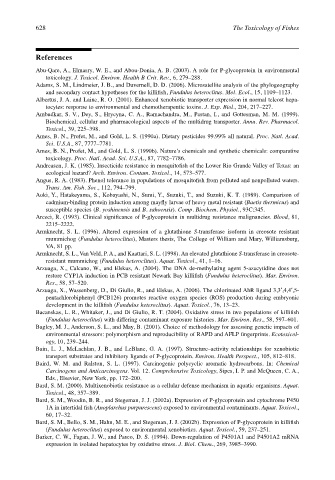Page 648 - The Toxicology of Fishes
P. 648
628 The Toxicology of Fishes
References
Abu-Qare, A., Elmasry, W. E., and Abou-Donia, A. B. (2003). A role for P-glycoprotein in environmental
toxicology. J. Toxicol. Environ. Health B Crit. Rev., 6, 279–288.
Adams, S. M., Lindmeier, J. B., and Duvernell, D. D. (2006). Microsatellite analysis of the phylogeography
and secondary contact hypotheses for the killifish, Fundulus heteroclitus. Mol. Ecol., 15, 1109–1123.
Albertus, J. A. and Laine, R. O. (2001). Enhanced xenobiotic transporter expression in normal teleost hepa-
tocytes: response to environmental and chemotherapeutic toxins. J. Exp. Biol., 204, 217–227.
Ambudkar, S. V., Dey, S., Hrycyna, C. A., Ramachandra, M., Pastan, I., and Gottesman, M. M. (1999).
Biochemical, cellular and pharmacological aspects of the multidrug transporter. Annu. Rev. Pharmacol.
Toxicol., 39, 225–398.
Ames, B. N., Profet, M., and Gold, L. S. (1990a). Dietary pesticides 99.99% all natural. Proc. Natl. Acad.
Sci. U.S.A., 87, 7777–7781.
Ames, B. N., Profet, M., and Gold, L. S. (1990b). Nature’s chemicals and synthetic chemicals: comparative
toxicology. Proc. Natl. Acad. Sci. U.S.A., 87, 7782–7786.
Andreasen, J. K. (1985). Insecticide resistance in mosquitofish of the Lower Rio Grande Valley of Texas: an
ecological hazard? Arch. Environ. Contam. Toxicol., 14, 573–577.
Angus, R. A. (1983). Phenol tolerance in populations of mosquitofish from polluted and nonpolluted waters.
Trans. Am. Fish. Soc., 112, 794–799.
Aoki, Y., Hatakeyama, S., Kobayashi, N., Sumi, Y., Suzuki, T., and Suzuki, K. T. (1989). Comparison of
cadmium-binding protein induction among mayfly larvae of heavy metal resistant (Baetis thermicus) and
susceptible species (B. yoshinensis and B. sahoensis). Comp. Biochem. Physiol., 93C:345.
Arceci, R. (1993). Clinical significance of P-glycoprotein in multidrug resistance malignancies. Blood, 81,
2215–2222.
Armknecht, S. L. (1996). Altered expression of a glutathione S-transferase isoform in creosote resistant
mummichog (Fundulus heteroclitus), Masters thesis, The College of William and Mary, Williamsburg,
VA, 81 pp.
Armknecht, S. L., Van Veld, P. A., and Kaattari, S. L. (1998). An elevated glutathione S-transferase in creosote-
resistant mummichog (Fundulus heteroclitus). Aquat. Toxicol., 41, 1–16.
Arzuaga, X., Calcano, W., and Elskus, A. (2004). The DNA de-methylating agent 5-azacytidine does not
restore CYP1A induction in PCB resistant Newark Bay killifish (Fundulus heteroclitus). Mar. Environ.
Res., 58, 57–520.
Arzuaga, X., Wassenberg, D., Di Giulio, R., and Elskus, A. (2006). The chlorinated AhR ligand 3,3′,4,4′,5-
pentachlorobiphenyl (PCB126) promotes reactive oxygen species (ROS) production during embryonic
development in the killifish (Fundulus heteroclitus). Aquat. Toxicol., 76, 13–23.
Bacanskas, L. R., Whitaker, J., and Di Giulio, R. T. (2004). Oxidative stress in two populations of killifish
(Fundulus heteroclitus) with differing contaminant exposure histories. Mar. Environ. Res., 58, 597–601.
Bagley, M. J., Anderson, S. L., and May, B. (2001). Choice of methodology for assessing genetic impacts of
environmental stressors: polymorphism and reproducibility of RAPD and AFLP fingerprints. Ecotoxicol-
ogy, 10, 239–244.
Bain, L. J., McLachlan, J. B., and LeBlanc, G. A. (1997). Structure–activity relationships for xenobiotic
transport substrates and inhibitory ligands of P-glycoprotein. Environ. Health Perspect., 105, 812–818.
Baird, W. M. and Ralston, S. L. (1997). Carcinogenic polycyclic aromatic hydrocarbons. In: Chemical
Carcinogens and Anticarcinogens. Vol. 12. Comprehensive Toxicology, Sipes, I. P. and McQueen, C. A.,
Eds., Elsevier, New York, pp. 172–200.
Bard, S. M. (2000). Multixenobiotic resistance as a cellular defense mechanism in aquatic organisms. Aquat.
Toxicol., 48, 357–389.
Bard, S. M., Woodin, B. R., and Stegeman, J. J. (2002a). Expression of P-glycoprotein and cytochrome P450
1A in intertidal fish (Anoplarchus purpurescens) exposed to environmental contaminants. Aquat. Toxicol.,
60, 17–32.
Bard, S. M., Bello, S. M., Hahn, M. E., and Stegeman, J. J. (2002b). Expression of P-glycoprotein in killifish
(Fundulus heteroclitus) exposed to environmental xenobiotics. Aquat. Toxicol., 59, 237–251.
Barker, C. W., Fagan, J. W., and Pasco, D. S. (1994). Down-regulation of P4501A1 and P4501A2 mRNA
expression in isolated hepatocytes by oxidative stress. J. Biol. Chem., 269, 3985–3990.

